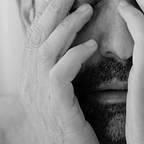The Nudes
NSFW
I grew up around photography, inspired (and distracted) by the nudes on the walls of my home — in particular, by Uelsmann, Weston, Bernhard, Callahan and Clerge. I was kicked out of my 4th grade for buying a Playboy from another kid. I felt the disparity between the bodies I saw every day at home, and the very strong reaction of the principal. I liked the grey zone there.
Uelsmann and Calahan offered reminders of how minimal a line could be that would convey feminine energy — just the right kind of curve, the right amount of shadow. It didn’t take much.
The essay question on my college application asked us to “use the space below to give us as complete a picture of you as possible.” I put emulsion on the page and responded with a naked selfie. I was accepted to the 218th class at Brown and I was told the photo was on the wall of the admissions office for the next 20 years.
When I got to college I hoped that by including nude figures in my photo-collages I’d seem more sophisticated, so I asked some classmates if they’d model during vacation. They did. But I never printed the images, embarassed as I was. They weren’t very good. It took 30 years before I found the negatives, scanned them, and showed them to the models. It was 30 years before I tried again.
But when I turned 50 I hired a model. I shot in the natural light of my San Francisco apartment. I liked the images as figure studies, a kind of compositional practice. When I showed my friend Molly the photos, she suggested I shoot her. Molly, a San Francisco physician and entrepreneur, showed her photos widely, and for the next 10 years I shot improvisational figure studies of a wide circle of friends in my mostly empty livingroom.
I’d seen boudoir photography, which was pretty much what I was doing, but I didn’t like the contrivances I saw in most productions— it always felt sexier if the model wasn’t modeling, wasn’t doing some unnatural thing, but rather, that I was a photojournalist and caught her being beautiful in the moment. At home. In bed. The shower. Waking up. Standing in the kitchen half dressed. Maybe a real fraction of a second as she passes from bedroom to closet. This is the private world where she is at her most natural.
My objective? Photos that capture the feeling of waking up and looking over at your lover in dim morning light; when you feel she’s the most beautiful woman you’ve ever seen. And you’re the luckiest guy on earth.
Since none were models, they were usually concerned with being identifiable. Engineers, lawyers, moms, artists, educators… they hung out with me at all times of light, the more inclement the weather, the better. The photos reveal a strange kind of immediate intimacy.
The apartment was highly constrainted: one big room with great light. A little bathroom. The only variable were the models and the weather. I developed a kind of moody boudoir style in San Francisco.
Said one model: “There was a desire to capture a beautiful moment, relatively organically, the way bodies move through space naturally.”
Even though the photos were fully improvisational, they were not “journalistic” scenes I just stumbled across; consequently I exclude them from the set of my photographic haiku. Still, they are extremely personal, and embrace many of the aesthetic properties of simplicity, a bit of mystery, and wabi sabi.
Post Script: Energy
The camera is an energy modulator — it takes the wholeness and intensity of things “out there” and it funnels it down through a little frame to me, where I can digest it safely.
The phenomenon is widely observed. War photographers are sometimes killed in battles when they’ve stood up in the middle of firefights. They disregard the danger all around them, or feel somehow impervious to it, seeing the world through the viewfinder like an omniscient spectator, and irrationally external to what is happening. The camera takes them out of the moment and makes them invisible.
I’ve felt this myself in smaller moments of danger when I rushed in with a camera (the bomb in Paris, the tornado in Gainesville, the active shooter in Santa Cruz), or even in the few times I’ve photographed a friend’s childbirth— I could feel my terror subside when I lifted the camera and experienced it through the viewfinder. I was okay as long as I was busy, working to compose what I was witnessing.
Same thing here.
In haiku, or in many Zen arts, like ikebana, there is always the quest to see how much can be done with very little. These sessions are explorations in subtraction and simplicity— how minimal can an image be and still convey its intimacy?
